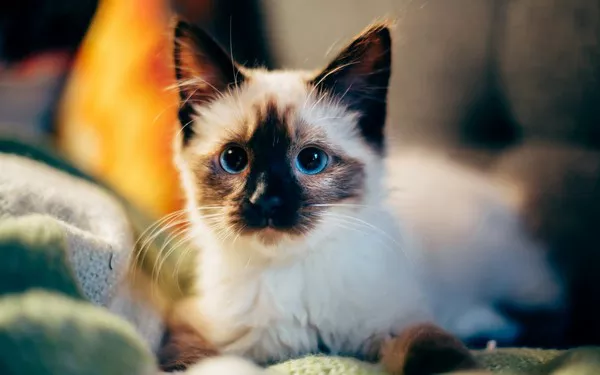Siamese cats, with their striking blue almond-shaped eyes and sleek, elegant appearance, have captivated cat lovers for generations. One of the most enduring and fascinating myths surrounding these felines is the belief that their eyes change color depending on their mood or the temperature of their environment. In this comprehensive exploration, we delve into the truth behind the captivating eyes of Siamese cats, uncovering the science, genetics, and unique characteristics that contribute to their seemingly ever-changing eye colors.
The Allure of Siamese Cats
Before delving into the enigmatic world of Siamese cat eye colors, it’s essential to appreciate the allure of this unique breed. Siamese cats are known for their striking physical features, which include a sleek, slender body, a short coat with color points on the ears, face, paws, and tail, and, of course, those captivating blue eyes. These cats are often described as “color-pointed” due to their unique coat pattern, and their striking eyes add to their overall charm.
Beyond their physical attributes, Siamese cats are renowned for their vocal and sociable nature. They are highly interactive and thrive on human companionship, making them affectionate and engaging pets. Their vocalizations, often described as “talking” or “chattering,” add to their distinctive personalities.
The Myth of Changing Eye Colors
The myth that Siamese cat eyes change color is a long-standing one, perpetuated by stories and legends surrounding this breed. According to these myths, the eye color of Siamese cats shifts in response to external factors, such as mood or temperature. However, the truth behind this phenomenon is more nuanced.
Eye Color Change Due to Age
One of the key factors contributing to the perception of changing eye colors in Siamese cats is their natural development as kittens. Siamese kittens are typically born with blue eyes, which is common in many cat breeds. As they grow and mature, their eye color gradually changes, usually settling into their permanent shade by the time they reach six months of age. This change is due to the development of pigments in the iris, which influences the eye’s color.
Temperature Sensitivity and Heat Map
Siamese cats’ color points are influenced by temperature sensitivity, a unique genetic trait. The enzyme responsible for pigment production in their fur and eyes, called tyrosinase, is heat-sensitive. Cooler areas of their body, such as the extremities, like the ears, face, paws, and tail, tend to develop darker coloration. This is why the color points on Siamese cats are often darker than the rest of their bodies.
To visualize this temperature sensitivity, you can think of Siamese cats as having a heat map on their bodies, with the cooler areas appearing darker. The color change in their fur is more pronounced when they are in cooler environments, such as air-conditioned rooms.
Permanent Eye Color
Contrary to the popular myth, once Siamese cats’ eyes settle into their permanent color, they remain relatively stable throughout their lives. The most common and iconic eye color for Siamese cats is deep blue. However, variations exist within the Siamese breed, and eye colors can include shades of blue, ranging from pale to dark, as well as blue-green or green.
The specific shade of blue or green in a Siamese cat’s eyes is influenced by a combination of genetics and the concentration of pigment in the iris. While their eye color might not change drastically, it can appear to vary slightly depending on lighting conditions and the angle at which you view the cat.
Genetics and Eye Color in Siamese Cats
To understand why Siamese cats have such captivating eye colors, it’s essential to explore the genetics at play. The genes responsible for coat color and eye color in Siamese cats are intertwined and fascinating.
The Role of Temperature-Sensitive Genes
Siamese cats possess temperature-sensitive genes that affect both their coat color and eye color. These genes are often referred to as “cs” or “colorpoint” genes. There are multiple variations of these genes, and they work together to create the signature color points on the cat’s body.
The Albinism Connection
Siamese cats are considered partially albino, which contributes to their unique coloration. The genes responsible for their coat and eye color are associated with a partial lack of pigmentation, resulting in the white coat and blue or green eyes. This partial albinism is what makes their eyes so striking against the backdrop of their creamy coats.
The Interaction of Genes
The interaction of genes involved in coat and eye color in Siamese cats is intricate. These genes dictate not only the distribution of pigments but also the temperature sensitivity of the enzyme tyrosinase. This sensitivity causes the cooler areas of the cat’s body to exhibit darker coloration, including the eye color.
Common Eye Colors in Siamese Cats
Siamese cats are known for their mesmerizing blue eyes, which are undoubtedly the most iconic and sought-after eye color within the breed. However, there are variations in eye color among Siamese cats, and these variations are typically determined by their genetic makeup.
Deep Blue Eyes
The majority of Siamese cats have deep blue eyes, which are often described as “sapphire” or “cobalt” in color. These striking blue eyes are a hallmark of the breed and are considered the most desirable eye color among Siamese enthusiasts.
Blue-Green Eyes
Some Siamese cats exhibit blue-green or aquamarine eyes. This eye color is less common but equally captivating. It is typically the result of a specific combination of temperature-sensitive genes and pigmentation.
Green Eyes
While less common than blue eyes, green eyes can also appear in Siamese cats. Green eyes in Siamese cats are typically a result of specific genetic combinations that lead to a higher concentration of pigmentation in the iris.
Factors Affecting Eye Color Variations
While genetics primarily dictate the eye color of Siamese cats, certain factors can influence the perception of eye color variations:
Lighting Conditions
The lighting in which you view a Siamese cat can affect the apparent color of their eyes. Natural daylight, artificial lighting, and even the angle of light can all impact how their eyes appear. In bright natural light, their eyes may appear lighter, while in dim lighting, they may appear darker.
Age and Development
As mentioned earlier, the eye color of Siamese kittens changes as they grow and develop. It is essential to observe their eyes over time to determine their permanent eye color.
Individual Genetic Variations
Each Siamese cat is a unique combination of genetic factors, resulting in variations in coat color and eye color. While certain traits are more common, there can be exceptions within the breed.
Conclusion
The allure of Siamese cats is undoubtedly enhanced by their striking and captivating eyes. While the myth of their eyes changing color in response to mood or temperature is not entirely accurate, the reality is equally fascinating. Siamese cat eye colors are primarily determined by genetics, temperature-sensitive genes, and the development of pigmentation in the iris. While their eye color may appear to vary under different lighting conditions, once their eyes settle into their permanent shade, they remain relatively stable throughout their lives.
Understanding the genetics and science behind Siamese cat eye colors allows us to appreciate these feline beauties on a deeper level. Whether you are captivated by the deep blue sapphire eyes or the mesmerizing blue-green hues, Siamese cats continue to enchant cat lovers worldwide with their unique and captivating eyes that add to their undeniable charm and allure.



























